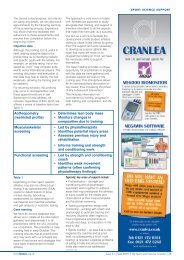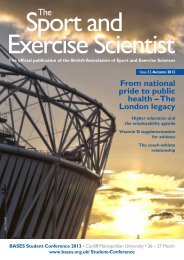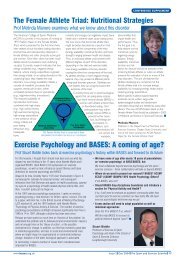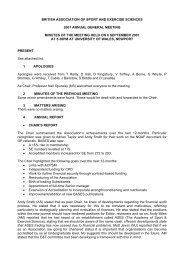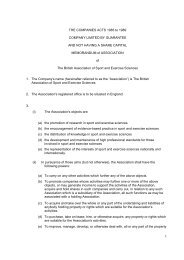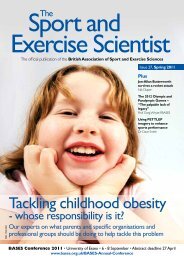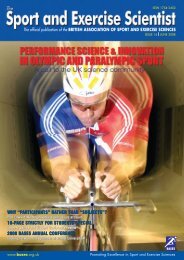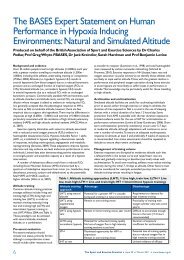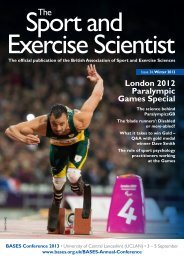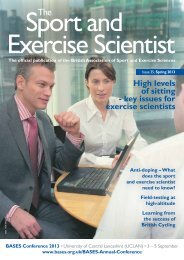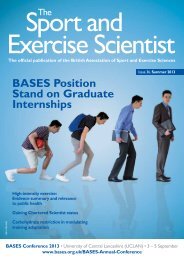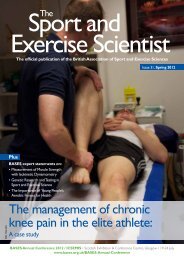Part 1 - Bases
Part 1 - Bases
Part 1 - Bases
Create successful ePaper yourself
Turn your PDF publications into a flip-book with our unique Google optimized e-Paper software.
ISSN 1754-3452<br />
The official publication of the BRITISH ASSOCIATION OF SPORT AND EXERCISE SCIENCES<br />
ISSUE 18 DECEMBER 2008<br />
OLYMPIC REPORTS<br />
Reflections from Beijing<br />
A focus on sprint and middle-distance running<br />
THE STUDENT ATHLETE<br />
An interview with Leeds Rhinos captain and recent<br />
Leeds Metropolitan University graduate Kevin Sinfield<br />
“COMMENTS FROM MEMBERS”<br />
Members take advantage of the new section<br />
www.bases.org.uk<br />
Promoting Issue Excellence 15 l March 2008 in Sport l The Sport and and Exercise Scientist Sciences l 1
FOREWORD<br />
The Sport and Exercise Scientist<br />
The SES is published quarterly by BASES<br />
Editor l Prof Andy Lane<br />
Editorial Advisory Board l Dr Daniel Bishop, Dr Melissa Day,<br />
Dr Lee Ingle, Dr Dominic Micklewright, Claire-Marie Roberts,<br />
Dr John Saxton, Dr Richard Thelwell, Dr David Tod, Len Parker-Simpson<br />
Book and Resource Review l Dr David Tod<br />
Advertising l Debbie Pearce<br />
Tel/ Fax: +44 (0)113 8128616 • dpearce@bases.org.uk<br />
Publisher l Mercer Print, Newark Street, Accrington BB5 0PB<br />
Tel: +44 (0)1254 395512 • info@mercer-print.co.uk<br />
BASES l Leeds Metropolitan University, Carnegie Faculty of Sport<br />
and Education, Fairfax Hall, Headingley Campus,<br />
Beckett Park, Leeds, LS6 3QT<br />
Tel/ Fax: +44 (0)113 812 6162/63 • jbairstow@bases.org.uk<br />
Website l www.bases.org.uk<br />
Disclaimer l The statements and opinions contained in the articles<br />
are solely those of the individual authors and contributors and are<br />
not necessarily those of BASES. The appearance of advertisements in<br />
the publication is not a warranty, endorsement or approval of<br />
products or services. BASES has undertaken all reasonable measures<br />
to ensure that the information contained in The SES is accurate and<br />
specifically disclaims any liability, loss or risk, personal or otherwise,<br />
which is incurred as a consequence, directly or indirectly of the use<br />
and application of any of the contents.<br />
Copyright © BASES, 2008 l All rights reserved. Reproduction in<br />
whole or in substantial part without permission of The SES Production<br />
Director is strictly prohibited. An archive of the The SES is available in<br />
the Member Area at www.bases.org.uk<br />
Copy deadline 1 January 2008 for Issue 19, March 2009. All<br />
contributions welcomed. Info for contributors www.bases.org.uk<br />
Front Cover Photo l Courtesy of Sally Trussler, Brunel University (© of Brunel University).<br />
Prof ANDY LANE<br />
Editor<br />
The Sport and<br />
Exercise Scientist<br />
Annual conferences are traditionally where members<br />
get together and share research findings, professional<br />
practice, interesting stories and a few jokes. Our<br />
feature article is on the highlights of the 2008 BASES Annual<br />
Conference. It is a combination of short articles from<br />
“conference reporters”. It was a vibrant conference and I<br />
hope this message comes across.<br />
We introduce a new section, titled “Comments”, in which<br />
members can provide comment on issues that they see as<br />
relevant, anonymously if they wish. In this issue, sport and<br />
exercise psychologists provide comments on which Dr Chris<br />
Harwood and Dr Jo Thatcher develop and extend these<br />
arguments.<br />
The Olympic Games will be in the forefront of our minds<br />
over the next four years. With our recent successes from<br />
Beijing to build on, we will be including reflective reports<br />
from practitioners over the coming issues. This issue features<br />
articles on running and boxing.<br />
Our Strictly for Students section contains an interview with<br />
Kevin Sinfield, a professional rugby player and recent sport<br />
and exercise science graduate. Kevin discusses the value of<br />
sport and exercise science to professional sport and the<br />
challenge of competing in high-level sport whilst studying for<br />
a degree.<br />
A fellowship of BASES is the highest accolade the organisation<br />
can provide. Our final article contains a report from Prof<br />
Andy Jones, a BASES fellow, on research presented at the<br />
European College of Sport Science conference.<br />
I hope you enjoy this issue.<br />
Prof Andy Lane<br />
Editor<br />
A.M.Lane2@wlv.ac.uk<br />
CONTENTS<br />
4 THE 2008 BASES ANNUAL CONFERENCE;<br />
HIGHLIGHTS FROM BRUNEL UNIVERSITY<br />
Conference reporters describe their experiences<br />
12 NEWS<br />
15 APPLYING SPORT PSYCHOLOGY IN THE GOLFING ARENA<br />
Extracts from the BASES online discussion<br />
that was held recently with Allison Dyer<br />
16 “WHITE” MEN CAN’T RUN:<br />
WHERE IS THE SCIENTIFIC EVIDENCE?<br />
BASES International Travel Grant winners<br />
Yannis Pitsiladis and Robert Scott report<br />
18 SUPPORTING COMBAT SPORTS BEFORE AND DURING<br />
THE OLYMPIC HOLDING CAMP<br />
Holding camp psychologist Pete Lindsay<br />
summarises and reflects<br />
20 “COMMENTS”<br />
Members voice opinions, Dr Chris Harwood and<br />
Dr Jo Thatcher add further discussion<br />
22 ELITE SPORT AND STUDYING<br />
SPORT AND EXERCISE SCIENCE IN<br />
ELITE RUGBY<br />
An interview with Kevin<br />
Sinfield, Leeds Rhinos captain<br />
24 RESOURCE AND<br />
WORKSHOP REVIEWS<br />
26 WORKSHOP AND RESOURCE REVIEWS<br />
28 JOLLY, FAT AND FIT: ARE SANTA CLAUS<br />
AND HIS GOOD WIFE ROLE MODELS FOR THE<br />
HAHA (HAPPY, ACTIVE? HEALTHY, ACTIVE<br />
LIFESTYLE) PARADIGM?<br />
Dr Sean Carroll, Erika<br />
Borkoles and Prof Remco<br />
Polman take up the story<br />
31 PROVIDING INSIGHTS INTO<br />
RESPIRATORY CONTROL DURING<br />
EXERCISE BASES<br />
Fellow Prof Andy Jones reports<br />
4<br />
16<br />
www.bases.org.uk<br />
Issue 18 l Dec 2008 l The Sport and Exercise Scientist l 3
COURTESY OF SALLY TRUSSLER, BRUNEL UNIVERSITY<br />
ANNUAL CONFERENCE HIGHLIGHTS<br />
THE 2008 BASES AN<br />
HIGHLIGHTS FROM BRUNEL UNIVERSITY • HIGHLIGHTS FROM B<br />
The 2008 BASES Annual Conference, held at Brunel University, was attended by over 600<br />
delegates, packed with interesting keynotes, symposia, debates, oral and poster presentations,<br />
and coupled with an excellent social programme. A group of delegates volunteered to act as conference reporters<br />
and agreed to write short reports on sessions of their choice. This article describes their experiences.<br />
Prof Dave Collins<br />
Day 1: Tuesday 2 September<br />
Opening Address and Opening<br />
Keynote: Reflections from Beijing,<br />
Prof Dave Collins<br />
Prof Collins’s departure from UK Athletics<br />
the day before added a sense of trepidation<br />
to his keynote delivery. The conference<br />
began with a welcoming introduction from<br />
Prof Ian Campbell who articulated the efforts<br />
made to organise the conference.<br />
This was followed by Prof Chris Jenks,<br />
Vice Chancellor of Brunel University, who<br />
explained the tradition of sport at Brunel,<br />
including the amalgamation of Borough<br />
Road, formerly West London Institute. Prof<br />
Richard Davidson, the Chair of BASES,<br />
espoused the exciting programme and<br />
recognised the achievements of recent<br />
conference organisers to making the Annual<br />
BASES Conference a priority when planning<br />
continuous professional development (CPD)<br />
activity. The scene was set for Prof Collins.<br />
I was particularly excited about Professor<br />
Collins’s keynote talk on two counts. Firstly,<br />
because of the timeliness of the<br />
presentation, with Prof Collins leading UK<br />
Athletics in the Olympic Games that had<br />
finished a couple of weeks previously.<br />
Secondly, because I know he is an excellent<br />
presenter. Prof Collins did not disappoint on<br />
either count.<br />
Prof Collins articulated the size of the<br />
challenge he faced when taking on the role<br />
leading UK Athletics. Despite a relatively<br />
successful World Championships in 2004, he<br />
warned of the dangers of mistaking a small<br />
number of outstanding individual<br />
achievements for an excellent structure.<br />
He proceeded to propose the key blocks<br />
needed to build this type of structure and,<br />
importantly, the role of sport science and<br />
medicine within this programme. He<br />
emphasised the importance of having an<br />
integrated and multidisciplinary approach in<br />
which sport scientists are fully fledged<br />
members of the team. He emphasised the<br />
importance of a sport scientist having good<br />
interpersonal skills. In particular, he indicated<br />
that what is critical for effectiveness is<br />
communication between all personnel<br />
within the performance management set-up.<br />
I felt that this was an excellent keynote and,<br />
moreover, from a CPD perspective, justified<br />
attending the conference, which, given it<br />
was the first presentation, was a pretty good<br />
start. <br />
Prof Andy Lane<br />
Andy is a professor of sport psychology at<br />
the University of Wolverhampton. He is<br />
BASES Accredited for Scientific Support and<br />
Research and a chartered psychologist with<br />
the British Psychological Society (BPS).<br />
Symposium on Supramaximal<br />
Exercise: A New Frontier in<br />
Integrated Physiology<br />
From a personal viewpoint, a symposium on<br />
supramaximal exercise was alluring, being<br />
the intensity domain for my PhD thesis.<br />
Prof Bengt Saltin led the symposium,<br />
outlining the main research areas requiring<br />
answers: the regulation of blood flow<br />
distribution; size of muscle mass in the true<br />
attainment of V . 02 max; reduction in stroke<br />
volume at high V . 02 max; and the cost of<br />
pulmonary ventilation. Dr Jerry Dempsey<br />
addressed the respiratory limitations to<br />
exercise, including oxyhaemoglobin<br />
desaturation, respiratory muscle energy<br />
cost/fatigue and the effect of intrathoracic<br />
pressure changes on stroke volume. Prof<br />
José Gonzáles-Alonso completed the trio<br />
by addressing the cardiovascular limitations,<br />
such as the differential ability of the brain vs.<br />
the muscle to compensate for reduced flow<br />
by increasing the arteriovenous 02 difference<br />
and the differential regulation of blood flow<br />
to the upper and lower extremities.<br />
Although the symposium did not directly<br />
address the physiological limitations of “real”<br />
supramaximal exercise as undertaken by the<br />
likes of Chris Hoy and co. (and the speakers<br />
acknowledged that their talks mainly<br />
addressed maximal exercise or thereabouts)<br />
4 l Issue 18 l Dec 2008 l The Sport and Exercise Scientist<br />
www.bases.org.uk
NUAL CONFERENCE<br />
RUNEL UNIVERSITY • HIGHLIGHTS FROM BRUNEL UNIVERSITY<br />
ANNUAL CONFERENCE HIGHLIGHTS<br />
COURTESY OF SALLY TRUSSLER, BRUNEL UNIVERSITY<br />
the presentations were fascinating and would<br />
have been equally of interest to those working<br />
in the more extreme intensity domains.<br />
Anna Wittekind<br />
Anna is a senior teaching fellow at the<br />
University of Essex and is also a PhD<br />
student investigating the physiological<br />
effect of prior exercise on supramaximal<br />
exercise.<br />
Review of the Psychology Oral<br />
Communications<br />
The psychology oral communications<br />
provided an interesting mix of topics, from<br />
transformal leadership to perceptual skills in<br />
badminton. An entertaining Dr Stuart<br />
Beattie reintroduced the catastrophe<br />
model and declared, “it’s here to stay”.<br />
Andrew Lane, Cardiff University (not to be<br />
confused with Prof Andy Lane, editor of The<br />
Sport and Exercise Scientist), hosted a<br />
knowledgeable discussion regarding elite<br />
performers’ sources of sport confidence. He<br />
highlighted to me that, as I coach, I should<br />
be examining my athletes’ sources of selfconfidence<br />
over time and emphasised that<br />
athletes derive their confidence from<br />
different sources, depending on the time<br />
prior to competition.<br />
Abbe Brady presented the only qualitative<br />
research of the session and ignited a reel of<br />
questions from the audience when she<br />
raised the issue that athletes do care about<br />
the image of their consultant. Of importance<br />
to practitioners, she suggested that our<br />
clothing might be a barrier to effective<br />
consultancy. So to all applied sport<br />
psychologists, dress appropriately as it’s<br />
what’s on the outside that counts.<br />
Amanda Wilding<br />
Amanda is a lecturer in sport sciences at<br />
Bournemouth University. She is BASES<br />
Accredited for Scientific Support and is<br />
part of the Hampshire county athletics<br />
performance and development coaching<br />
staff.<br />
Review of the Physiology Oral<br />
Communications<br />
The session started with a confident<br />
presentation by Paul Bradley about the yo-yo<br />
intermittent endurance test and was delivered<br />
very well with good expansion on the<br />
discoveries. As a result, a number of questions<br />
were asked, leading to a very good discussion to<br />
kick off the session; the only downside being<br />
that the session had surprisingly few numbers.<br />
This was followed by an applied physiological<br />
study on elite mountaineers, delivered by a<br />
first-time presenter at the BASES conference,<br />
Nicola Reeve, which was very interesting<br />
and novel. The next study took the route of<br />
the session to a more pure science arena,<br />
looking at genes and the endurance<br />
performance. This was a very interesting<br />
study, opening up a very wide range of<br />
questions and debate – could it be used for a<br />
sophisticated talent ID? The next two studies<br />
brought the session back to applied science,<br />
looking at a 6-week training intervention with<br />
walkers and the running economy on flat as<br />
opposed to uphill running. These studies,<br />
presented by Andrew Drake of Coventry<br />
University and Chris Loxston of the English<br />
Institute of Sport, were well-discussed by the<br />
audience, leading to interesting debate.<br />
Overall, the session was very informative, with<br />
a wide range of speakers, from lecturers to<br />
applied practitioners. The studies were very<br />
specific with varying levels of science. There<br />
was a good array of questions and debates,<br />
including pedantic questions, for example,<br />
“Explain the difference between efficiency and<br />
economy”. This got away from the topics at<br />
hand but was very well handled by the<br />
presenters. I thoroughly enjoyed the session.<br />
Jonathan Prichard<br />
Jonathan is a lab technician at the<br />
University of Northumbria and is<br />
currently working towards BASES<br />
Physiology Accreditation for Scientific<br />
Support.<br />
Prof Bengt Saltin<br />
Symposium Report – The Role of<br />
Implicit Cognitions in Sport<br />
This highly engaging symposium comprised<br />
four short research presentations that<br />
explored the influence of implicit processes<br />
on perception and performance, primarily<br />
within a soccer environment. Firstly, Dr<br />
Robin Jackson focused on players’ ability<br />
to distinguish between genuine and<br />
deceptive movement, where he reported<br />
highly skilled performers to be less<br />
susceptible to deception than their<br />
recreational counterparts. Although the<br />
specific mechanisms for this were not<br />
presented, it was suggested that players<br />
should consider developing their ability to<br />
disguise movements. Next, Dr John van<br />
der Kamp discussed whether penalty<br />
takers (PTs) should fixate on goalkeepers<br />
(GKs) during the run-up to the penalty kick.<br />
The data suggested that if a PT looks at the<br />
GK, they are more likely to kick within the<br />
GK’s reach. Further, it was reported that<br />
GKs can look up to 9% taller when they<br />
stand with their arms up compared to when<br />
they stand with their arms down. With the<br />
perceptual estimates of GK height being so<br />
drastic, the potential impacts on kicking<br />
accuracy will be reinforced should a PT<br />
fixate on the GK. The third presentation,<br />
from Dr Jamie Poolton, examined how<br />
the reputation of a GK can implicitly<br />
influence the perception of their size. The<br />
key message here was that if a GK has a<br />
reputation for saving penalties, they would<br />
be perceived as larger, and if PTs fixate on<br />
the GK, their kicking accuracy would be<br />
reduced further.<br />
“Overall, the session was very<br />
informative, with a wide range<br />
of speakers . . . . “This highly<br />
engaging symposium . . . .”<br />
To conclude, Prof Rich Masters reported<br />
how psychological stress might influence<br />
perception in sport. Although not within a<br />
soccer context, the evidence suggested that,<br />
under stressful situations, successful<br />
performers have better perceptions of<br />
important factors within the environment. In<br />
summary, the symposium addressed a<br />
number of topical issues within the area of<br />
implicit cognition. Further to this, the<br />
manner in which the presentations logically<br />
developed from one to another enabled<br />
more defined suggestions for future research<br />
and applied practice.<br />
Dr Richard Thelwell<br />
Richard is a principal lecturer in sport<br />
psychology at the University of<br />
Portsmouth. He is also BASES Accredited<br />
for Scientific Support and Research.<br />
www.bases.org.uk<br />
Issue 18 l Dec 2008 l The Sport and Exercise Scientist l 5
ANNUAL CONFERENCE HIGHLIGHTS<br />
Day 2: Wednesday 3<br />
September<br />
Keynote: Physical Activity and<br />
Health: A Governmental Approach<br />
The physical activity and health keynote<br />
session began with the disappointing news<br />
that, due to being called away to deal with<br />
an emergency in Africa, the Chief Medical<br />
Officer for England, Sir Liam Donaldson,<br />
would not be presenting. Fortunately for the<br />
BASES Conference attendees, Jane Riley,<br />
the Associate Director of Public Health for<br />
Yorkshire and the Humber, ably stepped into<br />
the breach at the last minute.<br />
Riley delivered an excellent presentation<br />
outlining the government’s approach to<br />
promoting physical activity (PA) and<br />
improving the health of the nation. She<br />
began with statistics proposing that only<br />
40% of men and 28% of women achieve<br />
the recommended activity levels of 30<br />
minutes of moderate intensity PA for 5 or<br />
more days a week. Riley informed the<br />
audience that although life expectancy was<br />
increasing, disease-free life expectancy was<br />
not keeping pace. She also warned of the<br />
economic cost to the NHS of the rising<br />
prevalence of obesity (£6 billion in 2008).<br />
However, Riley suggested that active adults<br />
have a 20–30% lower risk of premature<br />
death, and a 50% reduced risk of<br />
developing major chronic diseases.<br />
Riley went on to share some fascinating<br />
insights from governmental research into the<br />
perceptions of parents and their influence on<br />
their children. Among these insights were<br />
the dangers of parents believing that a happy<br />
child is a healthy child, and that many<br />
parents do not cook for their children due<br />
to a lack of knowledge and confidence. Riley<br />
informed us that children are often allowed<br />
and encouraged to be sedentary, for<br />
example, sitting in front of TV is used as a<br />
method of behavioural control and family<br />
bonding. Riley then summarised national,<br />
regional, and local government initiatives,<br />
such as the £30 million “healthy towns”<br />
initiative, Sport England, plans for a<br />
partnership with the entertainment industry,<br />
and the new “Change 4Life” initiative.<br />
In closing, she urged sport scientists to make<br />
information easier to understand and more<br />
readily available to the public, and<br />
emphasised that the focus should be on<br />
promoting fun rather than trying to force<br />
people to become more active out of fear.<br />
Symposia: Lifestyle vs. Chronic<br />
Disease – <strong>Part</strong> 1<br />
In opening, Dr Gary O’Donovan<br />
(University of Exeter) outlined the purpose<br />
of the session: To pool the resources of<br />
leading experts in physical activity, diet,<br />
exercise psychology and urban planning, in<br />
the fight against chronic disease.<br />
Firstly, Prof Chris Riddoch (University of<br />
Bath) provided a thought-provoking<br />
discussion on the importance of physical<br />
COURTESY OF SALLY TRUSSLER, BRUNEL UNIVERSITY<br />
activity. The dose-response relationship<br />
between physical activity and chronic disease<br />
risk was vividly illustrated by the use of<br />
numerous studies showing a reduced risk of<br />
chronic disease with rising levels of activity,<br />
and diminishing benefits with further rises in<br />
activity levels. He presented research to<br />
show that those with acceptable levels of<br />
physical fitness but with excess body fat do<br />
not necessarily have an increased risk of<br />
chronic disease. It appears that fit people<br />
have more “protection” against disease<br />
regardless of body fat levels. He concluded<br />
by urging that we take a more socioecological<br />
view of behaviour, considering the<br />
individual, social factors, the physical<br />
environment and the influence of society.<br />
Next, Dr Amelia Lake (University of<br />
Newcastle) examined the importance of diet<br />
in the battle against chronic disease. She<br />
indicated that foresight projections predict a<br />
70% increase in diabetes and that, by 2050,<br />
obesity could rise by 60%. She outlined the<br />
current strategy of modifying diets to<br />
prevent chronic disease by decreasing salt<br />
and fat intake, and increasing fruit and<br />
vegetable intake. Dr Lake offered a<br />
stimulating insight into the influence<br />
obesogenic environments and “foodscapes”<br />
have on public health. She acknowledged<br />
that lower socioeconomic status<br />
neighbourhoods appear to be exposed to<br />
more fast-food options and fewer healthyeating<br />
options. Her own findings from<br />
research on the foodscape in<br />
Northumberland between 1980 and 2000,<br />
showed a dramatic increase in the number<br />
of “food eaten out of the home” events (i.e.,<br />
takeaways) and demonstrated an association<br />
between the changing foodscape and<br />
increases in body mass index in this area.<br />
Symposia: Lifestyle vs. Chronic<br />
Disease – <strong>Part</strong> 2<br />
Dr Guy Faulkner (University of Toronto)<br />
gave an entertaining and enlightening<br />
presentation on the role exercise psychology<br />
can play in the promotion of PA and the<br />
prevention of chronic disease. He espoused<br />
that the psychological, behavioural and social<br />
determinants of PA should be used as the<br />
basis for interventions to promote PA. Dr<br />
Faulkner discussed the difficulties of<br />
establishing set recommendations on exercise<br />
dosage for promoting mental health and<br />
questioned the effectiveness of using energy<br />
expenditure to set exercise dosages for<br />
mental health. Dr Faulkner closed by<br />
emphasising that although rigorous<br />
experimental research is needed for practical<br />
interventions,“acts need not wait for evidence”.<br />
In the concluding presentation, Dr Billie<br />
Giles-Corti (University of Western<br />
Australia) delivered an engaging account of<br />
the role of the environment in the<br />
prevention of chronic disease. She<br />
introduced the concept of the built<br />
environment, which encompasses the<br />
influence that land use, transportation<br />
systems, and urban design have on PA<br />
levels. Findings from transport literature<br />
detailed how the proximity of shops and<br />
mixed land use to people’s homes influences<br />
PA levels. Urban design research revealed<br />
that factors such as convenience of facilities,<br />
access to public space, aesthetics and the<br />
presence of cycle and walk pathways all<br />
affect the levels of PA.<br />
She vividly illustrated the extent to which the<br />
above factors affect PA levels between<br />
children, adolescents and adults. In children,<br />
growing parental concerns about personal<br />
and traffic safety were said to be adversely<br />
affecting the PA levels of children. While for<br />
older adults the biggest influences on PA<br />
levels were access to parks, proximity of<br />
destinations, safety, bothersome traffic and<br />
the quality of paths. In closing, Dr Giles-<br />
Corti implored that cities and towns should<br />
cater for multiple groups and multiple<br />
activities in multiple settings.<br />
Ian Lahart<br />
Ian is a sports therapy lecturer in the<br />
University College Birmingham and<br />
recently completed an MSc in Applied<br />
Sport and Exercise Science at the<br />
University of Wolverhampton.<br />
Campus central spine<br />
6 l Issue 18 l Dec 2008 l The Sport and Exercise Scientist www.bases.org.uk
ANNUAL CONFERENCE HIGHLIGHTS<br />
Prof Chris Jenks, Vice Chancellor of Brunel University<br />
Prof Rich<br />
ALL PICS COURTESY OF SALLY TRUSSLER, BRUNEL UNIVERSITY<br />
Delegates<br />
Biomechanics and Physiology Oral<br />
Communications<br />
I was really impressed with the variety of<br />
biomechanics at the BASES Conference this<br />
year, with something for everyone. With the<br />
title of this session incorporating both<br />
biomechanics and physiology, I was<br />
expecting a predominance of physiology,<br />
especially with the recent decline in<br />
biomechanists in the Association. However,<br />
clever/astute scheduling saw a happy<br />
combination of applied presentations that<br />
incorporated both biomechanical and<br />
physiological components and, as a result, I<br />
am sure this session was beneficial to the<br />
biomechanist and the physiologist alike.<br />
What was particularly impressive was the<br />
array of applications covered within this<br />
session, ranging from markers of appetite<br />
suppression to breast movement. It was<br />
encouraging to see presenters from a variety<br />
of backgrounds, including clinicians,<br />
academics, students and practitioners. Useful<br />
guidance was given on appropriate types of<br />
breast support, stretching exercises for<br />
lower back pain sufferers and kinematic<br />
monitoring of the centre of mass during<br />
exercise. There was a slightly disappointing<br />
number of people in the audience, but<br />
those that were there contributed to<br />
interesting discussions on various areas and<br />
were privy to some excellent presentation<br />
skills. The session was very well chaired by<br />
Dr Tom Korff who encouraged lively<br />
discussions throughout.<br />
Joanna Scurr<br />
Joanna is a principal lecturer in biomechanics<br />
at the University of Portsmouth and is BASES<br />
Accredited for Scientific Support. Joanna’s<br />
research focus is breast biomechanics.<br />
Exercise and Heart Failure<br />
Symposium<br />
This novel and informative symposium was<br />
chaired by Dr John Buckley and<br />
comprised a series of themed presentations<br />
on heart failure from UK experts in the field.<br />
Dr Jenni Jones briefly outlined the<br />
aetiology of heart failure and provided some<br />
shocking “hot-off-the-press” statistics for<br />
new levels of risk factors for cardiovascular<br />
disease from the European Cardiovascular<br />
Society Meeting. Dr Rob Shave then<br />
outlined the importance of brain natriuretic<br />
peptide as a biomarker for detection of<br />
heart failure. Cathy Bindoff delivered an<br />
excellent presentation on the groundbreaking<br />
use of left ventricular assisting<br />
devices in severe heart failure at Harefield<br />
Hospital. The exercise-related segment of<br />
the symposium saw Dr Paul Bromley,<br />
Patrick Doherty, Fiona Lough and Dr<br />
Lee Ingle provide the audience with<br />
insightful information on exercise testing and<br />
prescription in heart failure patients. The<br />
take-home message was that both field tests<br />
and full cardiopulmonary exercise testing can<br />
be used to assess functional capacity in heart<br />
failure patients, and that a mixed-modality<br />
exercise training programme including<br />
resistance- and interval-type aerobic exercises<br />
is beneficial to heart failure patients in terms<br />
of providing an enhanced quality of life.<br />
Gavin Sandercock<br />
Gavin is a lecturer in cardiac<br />
rehabilitation at the University<br />
of Essex.<br />
Day 3: Thursday<br />
4 September<br />
Introduction and Keynote:<br />
Biopsychosocial Support Systems<br />
and the Role of the Sports Scientist<br />
The third keynote presentation was given<br />
early on the third day of the Conference by<br />
Dr Trisha Leahy of the Hong Kong Sports<br />
Institute. Any cobwebs lingering from the<br />
entertainment of the previous evening were<br />
soon swept aside by what turned out to be<br />
an extremely engaging presentation. Dr<br />
Leahy opened her presentation by relating<br />
sports development systems for young<br />
athletes to the 1990 Convention of Rights of<br />
the Child. There was particular reference to<br />
Article 29 which states: a child’s education<br />
(including sport) “shall be directed to the<br />
development of their personality, talents and<br />
mental and physical abilities at their fullest<br />
potential”. Although I had broadly<br />
recognised the importance of individualising<br />
the support and opportunities given to<br />
young athletes, I had certainly never<br />
considered them in the human-rights terms<br />
described by Dr Leahy.<br />
With the rights of the child in relation to<br />
sport clarified, Dr Leahy continued by<br />
discussing issues of safeguarding young<br />
athletes. As the title of her presentation<br />
implies, she emphasised the importance of<br />
safeguarding against physical, psychological<br />
and social threats that young athletes are<br />
inevitably exposed to during the course of<br />
participating in sport. Dr Leahy focused<br />
much of her talk on the threat of sexual<br />
abuse that young athletes may experience,<br />
which she explained is a worldwide<br />
problem. Alarming figures were given that<br />
suggested approximately 30% of all athletes<br />
under the age of 18 years had reported being<br />
the victim of sexual abuse, of which half had<br />
occurred in a sports context. According to Dr<br />
Leahy, mechanisms to prevent and protect<br />
against sexual abuse are rarely able to<br />
overcome factors such as the reluctance to<br />
expose perpetrators, bystander effects and<br />
victim confusion, fear and entrapment.<br />
Overall, the presentation was delivered in a<br />
very engaging way and culminated in quite<br />
an emotionally charged and protracted Q&A<br />
session. It was clear that many people in the<br />
audience felt very strongly about the issues<br />
covered in Dr Leahy’s talk, which certainly<br />
raised awareness about the prevalence of<br />
risks to the welfare of young athletes. Dr<br />
Leahy concluded by pointing out that<br />
systematic risks to sports systems will only<br />
occur if psychological abuse by coaches is<br />
normalised, rather than challenged.<br />
Dominic Micklewright<br />
Dominic is a BPS-chartered sport and<br />
exercise psychologist and a lecturer at the<br />
University of Essex. He has been an<br />
editorial board member of The Sport and<br />
Exercise Scientist since January 2007.<br />
Symposium: Metabolic and Vascular<br />
Health in Young People<br />
Childhood obesity continues to rise and its<br />
prevention has turned into one of the UK<br />
government’s main priorities. As an exercise<br />
physiologist with an interest in paediatric<br />
exercise science, I was looking forward to<br />
this symposium.<br />
The first presentation was given by Dr Joe<br />
Eisenmann of Michigan State University,<br />
and was entitled “Fatness, Fitness and<br />
Metabolic Syndrome in Children and<br />
Adolescents”. He began his presentation<br />
with a brief overview of previous findings<br />
about the relationship between obesity,<br />
fitness and metabolic syndrome in children.<br />
8 l Issue 18 l Dec 2008 l The Sport and Exercise Scientist<br />
www.bases.org.uk



